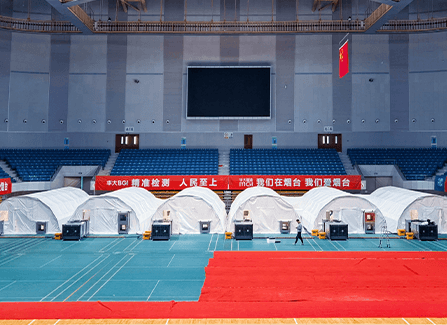News
Site Editor
 Site
/uploads/image/677267645dfcf.png
The negative pressure is maintained inside the building where the patient is treated so that no contaminant will escape into the healthy environment. Negative pressure rooms are also named isolation rooms, designed specifically to restrict airborne germs into the place where they originate.
Site
/uploads/image/677267645dfcf.png
The negative pressure is maintained inside the building where the patient is treated so that no contaminant will escape into the healthy environment. Negative pressure rooms are also named isolation rooms, designed specifically to restrict airborne germs into the place where they originate.
Everything You Need to Know About a Negative Pressure Hospital
Views: 2330
Author: Site Editor
Publish Time: 2023-03-13
Origin: Site
Negative pressure hospitals are such kinds of buildings and rooms, with low air pressure inside compared to outside.
The negative pressure is maintained inside the building where the patient is treated so that no contaminant will escape into the healthy environment. Negative pressure rooms are also named isolation rooms, designed specifically to restrict airborne germs into the place where they originate.
Working in a negative-pressure hospital
A negative-pressure hospital is structured so that the purpose of contamination control and the treatment of patients under a controlled environment is achieved. The negative pressure room consists of the following;
A pressure unit that creates the difference of pressure inside out and keeps things in control. The isolation section is a fully restricted area because airborne microorganisms are ready to attack the person who entered once into that area.
An air cleaner is badly needed to clean the internal air that patients and their caretakers must breathe. The pressure unit inside the isolation room itself contains filters and air cleaners to reduce the microorganisms.
In the absence of air cleaners and filters, the isolation is just a room to separate the patient from others without his/her treatment because day by day, microorganisms will increase, which takes patients closer to death.

Categories of negative pressure hospital
Negative pressure hospital is classified into different categories based on the severity of the infectious diseases.
The most basic type of negative pressure room is class S, designed to have a simple air conditioning facility with normal airflow. Class S is restricted to the people that are not as threatening to them and others.
Immunocompromised patients are admitted to the class P of negative pressure hospital. Class P is designed to keep the patient away from the outside environment, so have a pressure unit and cleaner too.
Class N is specifically structured and functionalized to protect the people outside the room from the patient by creating negative pressure inside.
The highly restricted negative pressure class is class Q for the complicated situation. Patients with COVID-19 and AIDS are admitted to quarantine there for the allotted days, weeks, or months by a doctor.
Everything in this isolation class is automated because the patient is fully covered by the infectious microorganisms that quickly attack the healthy person if he/she enters this isolation room.
Importance of negative pressure hospital
Negative pressure hospitals are greatly beneficial because of their design and purposes. For example, isolation rooms are significant because of the following;
-
Infection control with the help of negative pressure inside the isolated rooms and, most importantly, the HEPA filters that remove the polluted air after filtration and recirculate the clean air inside for the fresh breathing of patients.
-
The protection of frontline workers by similarly creating negative pressure and restricting the movement of microorganisms into the room only.
Controlling the highly spreading viral disease by isolating the patient in the automated class Q of the negative pressure hospital.
A negative pressure hospital is a quarantine place for patients infected by contagious diseases.








